Portelet Bay and Harbour
Portelet is a beach and small harbour on the south-western tip of Guernsey, where it sits in the parish of Torteval.
It is popular with holidaymakers, with shallow waters, interesting rocks and generally good sand — although this is darker here than on many of the other beaches around the island. If you’re an aviation geek, it’s also a place where you can also lie back and watch the planes coming in and out of the airport directly overhead — so long as the wind is blowing in the right direction.
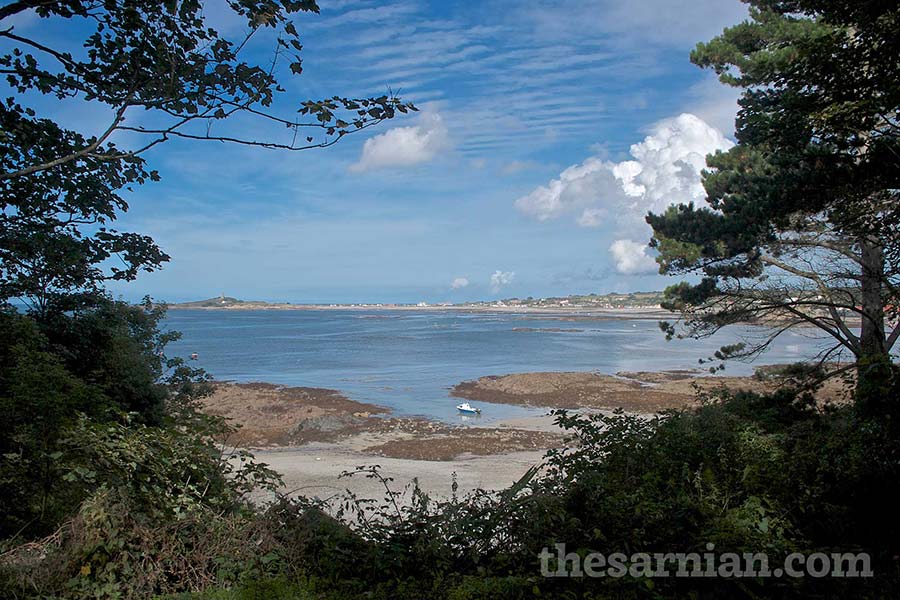
Oliver Carey keeps his boat, the Huffin’ Puffin, tied up in Portelet Harbour, in the same mooring spot on the harbour wall as his father, Remus Carey did. Sampson, the cat, lives there, too. As explained in book 1, Dead in the Water,
The lazy sweep of Rocquaine Bay carried his [Ollie’s] view to Fort Grey – the Cup and Saucer, the locals called it, in a nod to the barrel-like keep and the circular wall running round it. To the left it curled back on itself, taking the road to Portelet and the small granite harbour that Ollie called home. His boat was moored there, just as it had been before he’d returned to the island and the Huffin’ Puffin had still belonged to his father.

A path behind the beach leads on to a pleasant walk past the lighthouse keepers’ cottages to the fort at Pezeries Point. It was open to traffic at one time, but the road has now been closed for years as it is eroding and no longer strong enough to take vehicles, making it a quiet, safe and very pleasant route. Its meandering course takes it around the edge of the Pleinmont nature reserve.
A cobbled slipway leads down to the sand from a kiosk (below), which sits in a small, sheltered garden at the end of Rocquaine Bay.
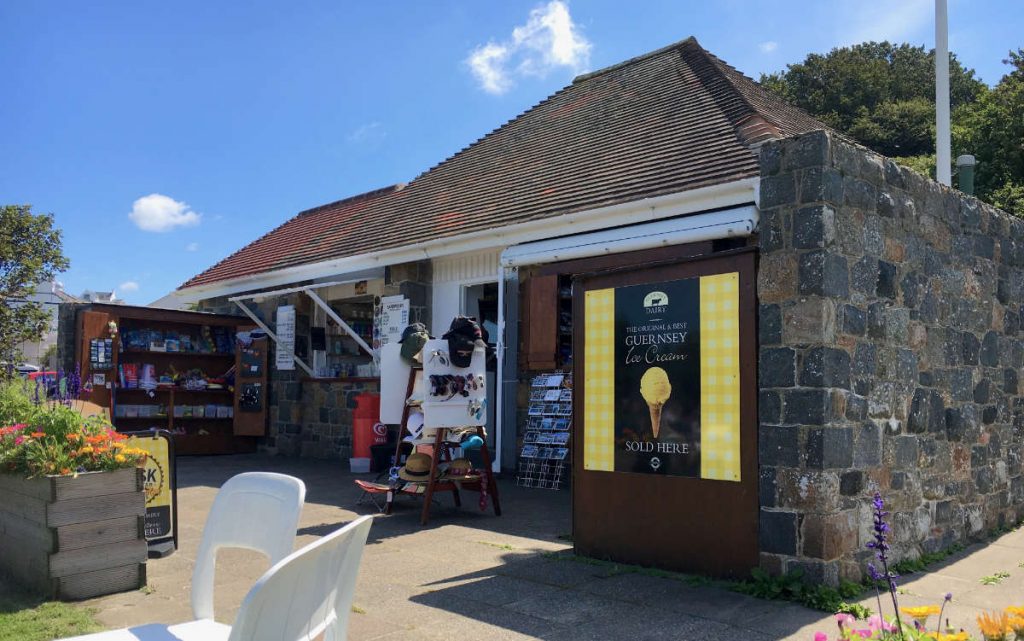
At the back of the bay there is a small granite hut (below), which Remus Carey uses as a storehouse, unloading important documents and other belongings into it before heading off in the Huffin’ Puffin on what may turn out to be more risky assignments. Although Ollie and his mother, Odette Carey, don’t know of his ownership of the hut, it becomes an important factor in book 2, Blowfish.

Rousse
Rousse Tower, a Napoleonic defensive position, sits on a headland to the north of the island. There is a kiosk there, and a small stone breakwater (see below). The water is particularly clear, and when looking towards Chouet beach on the opposite side of the bay it can sometimes look quite turquoise.
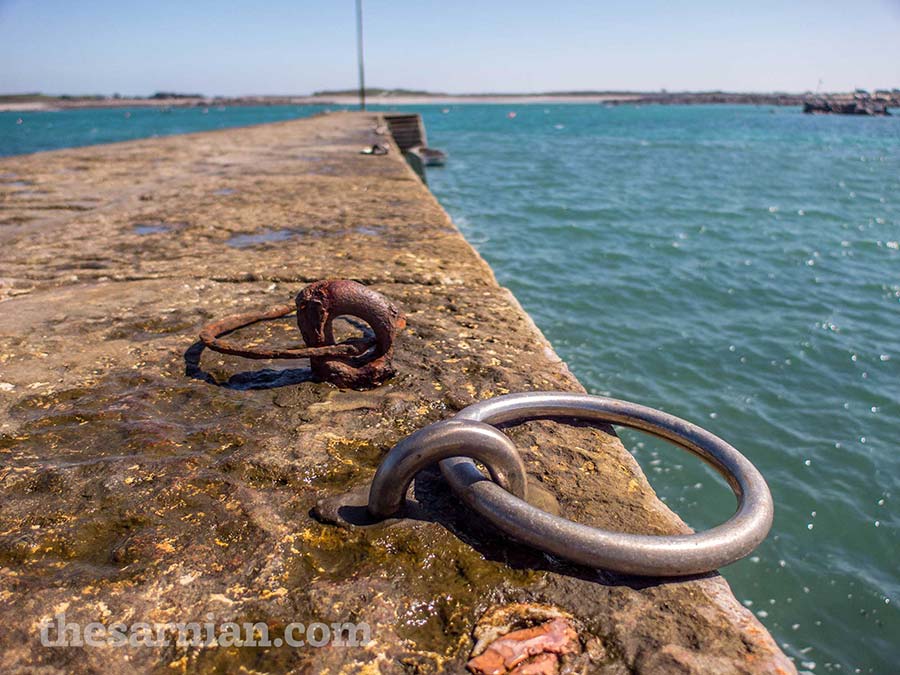

Kira Spooner‘s parents were the lesses of the kiosk throughout much of her childhood and all of her teenage years, and she used to work there in the summer when they were at their busiest. They eventually handed back the lease when she returned to the island after finishing her degree on the mainland.
She met George Dixon twice here in book one, Dead in the Water, initially regretting her choice of venue as she didn’t want to sully her happy memories of the place.

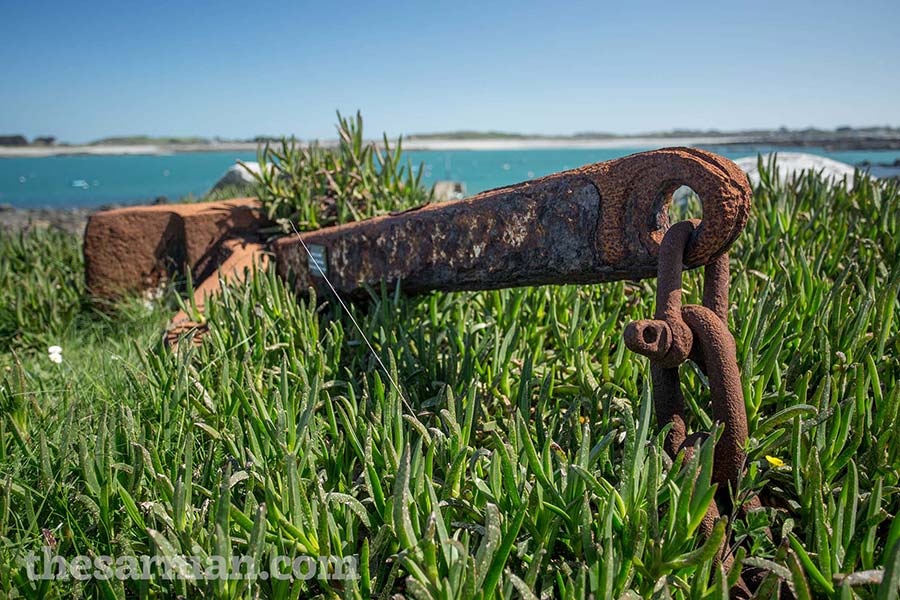
An artistically-abandoned anchor sits close to the breakwater within a patch of Hottentot Fig.

Above: Rousse from Ladies’ Bay
Little Russell

Little Russell is a channel that divides the islands of Guernsey and Herm. Ferries coming to Guernsey pass through it and it’s frequently used as a stopping point for cruise liners when visiting the island. When the sea is particularly rough, ferries are sometimes held in Little Russell until it is safe to enter that harbour at St Peter Port.
Little Russell is the body of water over which the annual air display takes place. You can cross it in around 15 minutes in a small boat.
Great Russell sits between Herm and Sark.

Thoumine, Thomas
Fictional character in the BBC radio drama The Fleet, who was left brain damaged following an accident shortly before the programme’s tenth anniversary episode.
He is played by George Dixon, who had originally been brought to Guernsey by Rosalynd Holdbrook when she was still editor of the programme. When she departed, Kira Spooner became Dixon’s boss when she assumed the editor’s position.
Spooner, Kira
As current editor of The Fleet, Kira Spooner took over upon Rosalynd Holdbrook’s retirement, unaware that it meant she would be working with one of the most difficult men in radio drama — George Dixon. She was born and raised on Guernsey, and her parents earned a living by running the kiosk at Rousse. She went to the mainland to study for a BSc (Hons) in Media Studies, and when she returned they handed back the lease on the kiosk. A passage in an early draft of book 1, Dead in the Water, since removed, explains some of the background to her association with the kiosk:
George Dixon was not far away. A few miles north, in view of the West Coast Road, he was squinting into the sun at Rousse Kiosk. Sitting across the table, blowing the steam on a mug of fresh tea, sat Kira Spooner, his boss at the BBC.
Of all the kiosks that dotted the coast, Rousse was by far her favourite. Her mother had taken the lease there the year that Kira turned four, and run it with help from her husband through to the end of Kira’s degree. Media Studies, BSc, it had taken her off to the mainland, and when she returned they’d handed the lease back to the States and moved to a bungalow overlooking Beaucette Marina. Now eighty and eighty-four, they walked to the kiosk each morning, crossing the neck of the island to sit at the tables they’d sanded and varnished and served for two decades with never a day spent wishing they’d done something else with their lives.
Rousse, then, the headland and its kiosk, was a place of happy memories, and the moment the words had left her mouth — ‘Rousse kiosk, half an hour’ — she wished beyond all else that she could have taken them back. Dixon agreed and rang off and she almost called him back, minded perhaps to change her mind and refuse his request for a meeting, or at least to change the venue. Then she thought better of it, reminding herself that however much she would rather he kept away from this special place, his opening gambit had surely been worse.
She was described during an editorial conference at The Sarnian as being ‘a reedy woman with bobbed black hair and thick rimmed glasses’. (book 1, Dead in the Water)
Erne, Alfie
Alfie Erne is the news editor of The Sarnian which he joined when he was poached from a rival newspaper two days before The Sarnian’s launch.
When we first meet him in book 1, Dead in the Water, he is described as,
…sixty, smart, with perfect hair and straight teeth and a reputation for doing things right. The old way. He didn’t sit on desks. He didn’t call meetings outside of the conference room.
He is technically Oliver Carey’s line manager, but he’s more interested in breaking news than guiding someone else’s career, and the paper’s overall editor, Freya Carlisle, is fine with that. She wants The Sarnian to get every story first so she’d rather than he did that anyway. As a result, she assumes most of his staffing responsibilities herself.
He is a tireless newshound and very good at his job. He has a knack of getting quotes and interviews that others cannot obtain, and also formulated the newspaper’s scandalous house style, which is largely credited with being responsible for its rapidly increasing sales. The style does not appeal to all, though, with many higher-minded characters, Marc Renouf among them, considering it little more than a rag.
Despite this, Renouf’s wife, Sophie, and the police force’s forensics officer, Charlie Dubois, both enjoy reading it.
Ozanne, Tony
Tony Ozanne is a lifestyle reporter on The Sarnian, where his brother, Harry Ozanne, works as art editor. Tony is the younger brother by one year.
As the lifestyle reporter he works closely with Ella Brouard, although as she is often dragged off the lifestyle desk to work on hard news pages when deadlines are pressing and big stories are breaking he often finds himself running the section single-handed.
Ozanne, Harry
Harry Ozanne is the art editor of The Sarnian newspaper, where his brother Tony Ozanne works on the lifestyle pages. Harry is the older of the two brothers, by a year.
He has control over the layout of the pages within the paper and so will work alongside Freya Carlisle, the editor, and Alfie Erne, the news editor, to allocate space within each publication. He is often found at the top of the table, alongside Freya, in the daily editorial conference, so that he can shuffle around the contents of the front page in real-time while the rest of the team watches what he’s doing on the projected image.
Whenever possible, he’ll argue for larger images and fewer images on the page.
Herm

Herm was a Crown Dependency from 1204 until the end of the Second World War, when the States of Guernsey purchased it for £15,000, so that it could be kept open for all to enjoy. It is now leased on a rolling basis, with the tenant required to maintain the island for the enjoyment of all.
Despite its size (0.77 square miles / 2 square km — 1.5 miles long, 0.5 miles wide) it is a haven for wildlife, with around 100 species of birds living there, including puffins and pheasants. The terrain is varied, with a common to the north occupying around a third of the landmass and leading down to the long golden sands of Shell Beach, and cliffs to the south falling to Belvoir Bay and the isle of Hermetier. Most of the island is granite.
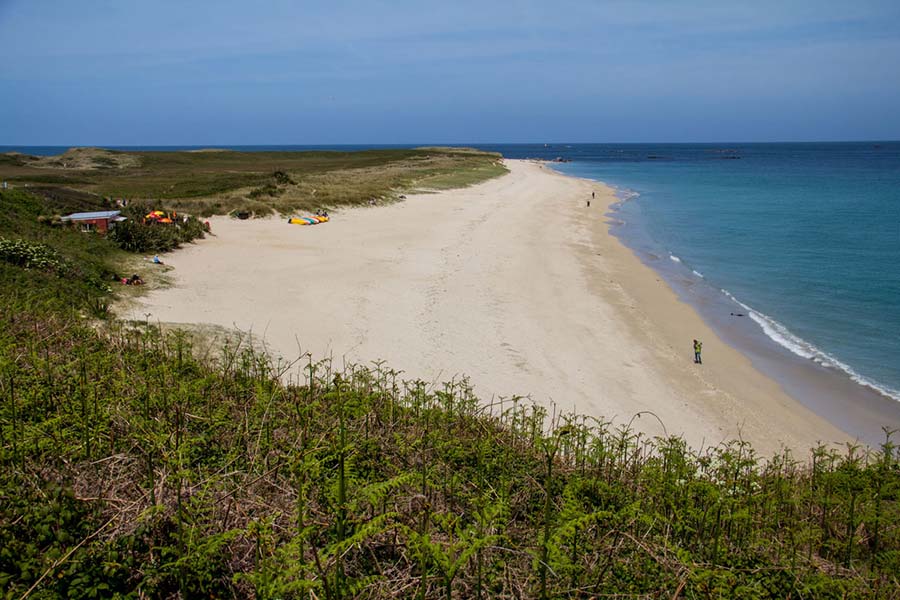
Shell Beach (above), formerly known as Le Mielle, is so-named because of the sheer quantity of shells that used to be deposited there by the Gulf Stream from as far away as Mexico. Present-day visitors, however, will find that except for among the rocks much of the beach if now covered in a slightly coarse sand rather than unbroken shells.
There are some great views of Shell Beach in this drone video, which also shows a lot of the common and the clear, clean waters surrounding the island.
Plant life is just as varied as the wildlife, with woodland on the upper slopes, gorse on the common, and New Zealand Flax on the fringes of the beach. The temperate climate allow for an abundance of semi-tropical plant types that are less common on the mainland.

Boats ply the three mile crossing between Guernsey and Herm year round, with the Trident ferry (above) doing good trade in the summer when tourists visit the island from St Peter Port. At high tide it docks at the main harbour, but when the tide is low it instead drops off and collects its passengers from the Rosaire Steps (below), a short distance to the south.

Harald Eggert, writing in The Channel Islands described the Rosaire Steps as ‘a rock with a cave’, and claimed that ‘the local people will tell you that this is where in earlier days a mermaid market was held: the luckless mermaids were chained to the rock while the bidding took place.’ At the time of his writing (1978), six shipping lines ferried passengers between Guernsey and Herm daily between May and October.

Legend has it that Sir Percival Perry, who leased Herm in the 1920s and 30s encased a pristine Model T Ford within the stonework of the harbour itself, although without demolishing it, it’s unlikely we’ll ever know the truth of this tale.
Aside from the kiosks at Shell Beach and Belvoir Bay, most of Herm’s buildings are clustered around the harbour. These consist of the gift shop, White House Hotel (no phones, televisions of clocks, previously the private home of Sir Percival Perry) and the Mermaid Tavern, which takes its name from the sailing ship that brought supplies to the island for three decades leading up to the 1900s.
The manor and non-denominational 11th century Chapel of St Trugal sit up on the crest of the hill, connected to the buildings below by a winding track. A small campsite sits close to the western shore, looking out towards Guernsey. A granite, windowless building in the grounds of the White House Hotel holds some claim to fame for the island, being the smallest prison in the world.
One of Anthony Gormley’s casts of his own body was loaned to the island for two years as part of an art project and installed on Le Petit Monceau (below). However, the £150,000 sculpture was too expensive for the island to keep hold of for longer, and so in 2012 when the loan came to an end it was returned to the artist.

It is governed directly from Guernsey, and forms part of the electoral district of St Peter Port South in the States of Deliberation. It is home to Britain’s smallest school, with just one classroom, and has had direct dial telephones through the Guernsey exchange since the installation of a 60-channel digital radio link in 1985. The BBC’s Domesday Project described the island’s power station setup in 1985:
It is situated in a central position at the top of the island in the old farm buildings. There are three DAF generators, each with a power output of 71 kilowatts, though normally only one is run at a time. The diesel oil which the engines use is shipped over from Guernsey by boat, and piped to the power house from the harbour. In summer about 300 litres of oil are used each day, and in winter when the number of people on the island is smaller, about 225 litres per day.
Chapel of St Trugal
The chapel was built in the 11th century when Herm was home to many monks. It is not known whether the original builders were merely followers of St Trugal, who lived in Normandy, or if the saint visited the island himself.
Its angled layout meant that the monks could sit in the nave, to the north, while the public would sit in the west, from which they would be unable to see the monks.
The chapel was significantly overgrown when Major Peter and Jenny Wood took over the leave of Herm, but they cut back much of the growth to uncover the west front, replaced the stained glass windows and established a garden there. Many of the new windows feature scenes significant to the island, with the BBC reporting that one depicts two Guernsey cows boarding Noah’s ark.
The chapel is not consecrated, and so non-denominational, but there are weekly services from visiting priests.

History of Herm
Herm has been occupied at least since Neolithic times (10200 – 2000BC), as tombs from that period are found on the island, but little is known about its inhabitants until the 6th century when it was occupied by monks. Some speculate that the name is a shortened version or hermit. At that time it was supposedly connected to the neighbouring island of Jethou (below) until the land between the two was swept away by a storm in 709.
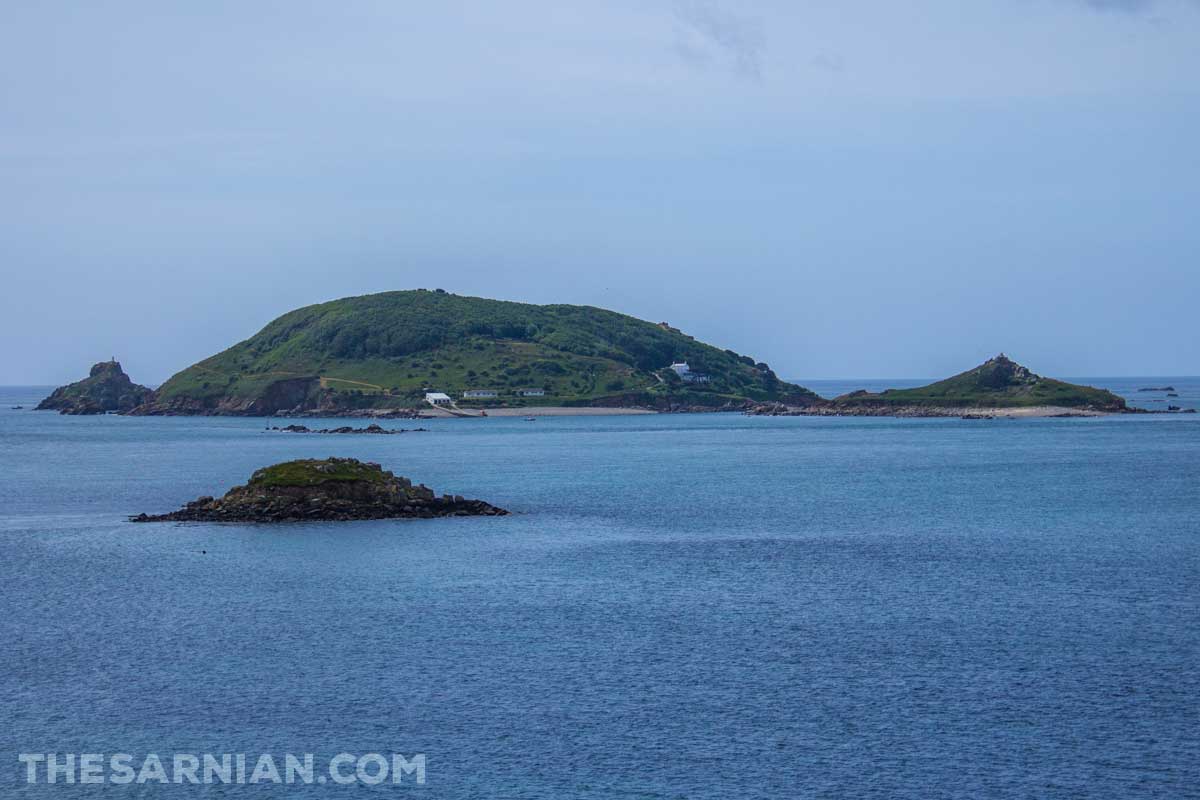

It became a part of the Duchy of Normandy, along with the rest of the Channel Islands, in 933, and an English Crown Dependency from 1204 onwards when Philip II of France took mainland Normandy from England, leaving the Channel Islands behind.
By the 1800s Herm’s rich granite deposits meant that it was used for quarrying (for which up to 400 people lived on the island at one time) and leased to tenants who, unlike the current tenants, treated the island as their private domains.
Herm during the Second World War
Unlike Guernsey, Jersey and Alderney, Herm was neither occupied nor fortified during the Second World, but its beaches were used by the German troops to practice troop landings in preparation for an invasion of Britain. They also shot a propaganda film there which, when shown back home in Germany, was claimed to be footage of a successful German landing on the Isle of Wight.
At the same time, the British forces had their eye on the, with a view to scoring a PR coup, with plans for raids on Herm, Jethou and Brecqhou on the night of 9/10 February 1943. Operation Hunchback, as it was known, would be conducted by 42 men, but was cancelled at the last minute due to bad weather, and finally conducted in a less grand scale (the plans for Jethou and Brecqhou were abandoned) on 27/28 February. It wasn’t a great success, and they found the island to be deserted.

Tenants of Herm
-
James Stevens Linklater
1884 – 1889Linklater isn’t mentioned by many sources that discuss the tenants of Herm. However, he appears to have purchased the island from Louis Numa Brard and Augustin Claude Broquin for £7375 on 6 August 1884. It further appears that he tried to sell the island again almost right away, initially to Britain, suggesting the it should mount a 35 ton cannon on the highest point to bring St Peter Port under its control. After several years of negotiations he sold the lease of the island to Prince Blucher. (Source: http://quivis.co.uk/herm/herm.html).
-
Gehbard Furst Blucher von Wahlstatt
1889 – 1914Famed for introducing wallabies to Herm, although none of these have survived to the present day, as they were housed in a zoo when Blucher left the island at the start of the First World War.
-
Compton Mackenzie
1920 – 1923Best known for writing Whisky Galore and The Monarch of the Glen, Mackenzie was born in Barra, Scotland, and a lifelong Scottish nationalist. He co-founded the Scottish Nationalist Party (SNP). He was tenant of both Herm and Jethou. He wrote two novels while on Herm, including Fairy Gold which included recognisable descriptions of the island.
-
Percival Lea Dewhurst Perry
1923 – 1939Chairman of the Ford Motor Company Ltd for 20 years from its incorporation in 1928, setting up its network of dealers, racing Ford cars and writing poetry to promote the vehicles. He opened Ford’s first factory outside of the US, in Manchester. He was the tenant of Herm until the start of the Second World War.
-
A G Jefferies
1948 – 1949The States of Guernsey leased Herm to A G Jefferies following its purchase at the end of the Second World War on two conditions. First, it should be open to the general public during summer daylight hours, and second, the island should not be altered in any way, so as to preserve its beauty.
Jefferies established Herm’s own postal service when the Postmaster General refused to reinstate the financially unviable post office that had operated for half an hour each day between 1925 and 1938. Jefferies’ service only conducted the mail as far as St Peter Port where it was handled for onward conveyance by the regular postal service, so anything sent from Herm had to carry two stamps — one issued by Herm and one by Britain. Herm stamps were attached to the backs of envelopes and the top left of postcards, and could also be used to pay for messages sent to Guernsey by carrier pigeon before the installation of a telephone line in 1954.
-
Major Peter and Jenny Wood
1949 – 1980The most famous of all of the tenants was Major Peter Wood (actually Major Alexander Gouch Wood) and his wife Jenny. They took over the 80-year lease in 1949 when the island was in a poor state, and made worse shortly thereafter when a naval mine, left over from the war, floated into the harbour, detonated against the wall and blew out most of the island’s remaining windows.
The major and his wife looked after the island until 1980, when they retired. He died in 1998, and Jenny wrote a book about their early life there, entitled Herm, Our Island Home, which described the work they undertook to bring it back to a habitable and commercially-viable condition. The opening page of the book describes the devastation caused by the blast:
We passed through the silent shattered village and reached the harbour and then we turned and looked back. The road was littered with seaweed, splintered stone and beach pebbles, so that we had to watch where we put our feet.
The roofs of the cottages were all awry and most of the windows were black and empty, blown in by the force of the blast from the mice which the night before had floated almost in the harbour on the rising tide and detonated with devastating force just 40 yards from the end of the mole, and only 100 yards from the centre of the village. Start against the skyline, 600 yards away, we could see that one of the barns was a skeleton, all the tiles blown off.
It was the 4th January 1952, and the British government had announced on 30 December 1951 that the English Channel could now be regarded as free of wartime mines. Just four days ago. Ironical.When Jenny Wood also died she was buried beside her husband in a grave outside the Chapel of St Trugal at the top of the island.
-
Adrian Heyworth and Penny Wood Heyworth
1980 – 2008From 1980 onwards, the lease was maintained by couple’s daughter, Penny Wood Heyworth, and her husband, Adrian. However, they put the remaining 40 years of the lease up for sale on 17 May 2008, initially for £15,000,000.
-
John and Julia Singer
2008 – presentThe lease was acquired in September 2008 by Starboard Settlement, reportedly for a far smaller figure than its sale price. Starboard Settlement, a trust that provided financial support for developing world charities, formed Herm Island Ltd to manage the island for its trustees, and vowed to maintain it in the condition under which they had acquired it.
John and Julia Singer became the new managers of the island, and moved there from Guernsey following the purchase. John was Starboard Settlement’s investment manager, and according to the UK’s Independent newspaper, the couple had ‘met and fallen in love on Herm 14 years [previously]’.
Transport
No cars are permitted on the island, and neither are bicycles (despite these being permitted on Sark, which also forbids cars). That doesn’t mean you won’t encounter a powered vehicle when walking on the island, though, as some residents use quad bikes or tractors to get around. There is also a tractor-hauled fire tender, although this is only used as a stopgap measure while awaiting assistance from the Guernsey Fire Brigade.
The ferry route between Herm and Guernsey is operated under license by the Trident Charter Company. The two boats in use — Trident V and Trident VI — are each licensed to carry 250 passengers, and generally run at 10 knots for a crossing time of between 15 and 20 minutes.
The speed limit for boating in the immediate vicinity of Herm is 6 knots.
Health and Safety
Herm has one resident special constable who is accompanied by two officers sent over from Guernsey on bank holidays. It has no doctor, and so medical assistance is offered in the first instance by a team of first aiders. Herm is served by the Flying Christine III naval ambulance, which will take a minimum of 45 minutes to reach the island from Guernsey.
The aforementioned fire tender has a capacity of 2000 litres and a 60 metre reel to pump it onto the source of the fire, operated by the island’s team of 10 retained firefighters. The island doesn’t have any fire hydrants because it doesn’t have mains water. All water on the island is drawn from boreholes sunk through the bedrock.
Herm photo gallery
Carlisle, Freya
One of the best newspaper editors of her generation, nobody quite knows what induced Freya Carlisle to take a job editing The Sarnian. She claims it was the challenge of launching a new title in a small market that drew her to the role, but few believe that considering how ambitious she is.
She is utterly devoted to breaking news and ruthless in her pursuit of a story, deploying her staff as though they were soldiers on a battlefield. This attitude and laser-like focus on her job is one of the reasons that her marriage failed, and she has since become estranged from her two children. Her only regular contact with them is through the medium of her cheque book.
Always fair but not always sympathetic to the needs of her staff if they conflict with the drive to secure a story, her first consideration is always the paper, which she rules with an iron rod. As described in book 1, Dead in the Water,
In all the time he’d been working for her, [Ollie had] heard her raise [her voice] just twice. Neither time had it carried the crisp, cool menace implicit with the more measured tones she used to berate her staff.
As a heavy smoker since school, her voice is now cracked and rasping, which only makes it sound all the more intimidating.
